
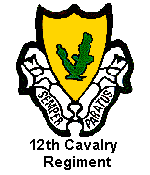
12th Cavalry Regiment
In Readiness
"Always Ready"


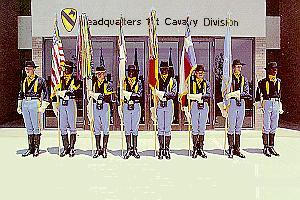 |
|---|
| 1st Cavalry Division Headquarters - 1971 |
|---|
| |
|---|

 On 05 May 1971, after 28 years, the colors of the 1st Cavalry Division, minus
those of the 3rd Brigade, were moved from Vietnam to Texas, its birthplace.
Using the assets and personnel of the 1st Armored Division, located at Fort
Hood, Texas the 1st Cavalry Division was reorganized, reassigned to III Corps
and received an experimental designation of the Triple-Capability (TRICAP)
Division. Its mission, under the direction of Modern Army Selected Systems
Test, Evaluation and Review (MASSTER) was to carry on a close identification
with and test forward looking combined armor, air cavalry and airmobile
concepts. The new 1st Cavalry Division consisted of the 1st Armored Brigade,
which the 2nd Battalion, 12th Cavalry Regiment, (formally the 5th Battalion,
6th Infantry) was assigned, the 2nd Air Cavalry Combat Brigade (ACCB), the 4th
Airmobile Infantry Brigade, Division Artillery who provided the fire support
and Support Command who provided normal troop support and service
elements.
On 05 May 1971, after 28 years, the colors of the 1st Cavalry Division, minus
those of the 3rd Brigade, were moved from Vietnam to Texas, its birthplace.
Using the assets and personnel of the 1st Armored Division, located at Fort
Hood, Texas the 1st Cavalry Division was reorganized, reassigned to III Corps
and received an experimental designation of the Triple-Capability (TRICAP)
Division. Its mission, under the direction of Modern Army Selected Systems
Test, Evaluation and Review (MASSTER) was to carry on a close identification
with and test forward looking combined armor, air cavalry and airmobile
concepts. The new 1st Cavalry Division consisted of the 1st Armored Brigade,
which the 2nd Battalion, 12th Cavalry Regiment, (formally the 5th Battalion,
6th Infantry) was assigned, the 2nd Air Cavalry Combat Brigade (ACCB), the 4th
Airmobile Infantry Brigade, Division Artillery who provided the fire support
and Support Command who provided normal troop support and service
elements.
 TRICAP, an acronym for TRIple-CAPability, was derived from combining the
ground (mechanized infantry or armor) capability, airmobile infantry and air
cavalry or attack helicopter forces. TRICAP I was held at Fort Hood, Texas
beginning in February 1972. The purpose of TRICAP I was to investigate the
effectiveness and operational employment of the TRICAP concept at battalion
and company levels when conducting tactical operations in a 1979 European
mid-intensity warfare environment. The exercise consisted of six phases;
movement to contact, defense and delay, exploitation, elimination of
penetration, rear area security and night elimination of penetration in an
adjacent area. On 28 June 1972, the 1st Battalion, 12th Cavalry returned from
Vietnam and replaced the 2nd Battalion, 12th Cavalry Regiment who was
inactivated on 29 June at Fort Hood, Texas.
TRICAP, an acronym for TRIple-CAPability, was derived from combining the
ground (mechanized infantry or armor) capability, airmobile infantry and air
cavalry or attack helicopter forces. TRICAP I was held at Fort Hood, Texas
beginning in February 1972. The purpose of TRICAP I was to investigate the
effectiveness and operational employment of the TRICAP concept at battalion
and company levels when conducting tactical operations in a 1979 European
mid-intensity warfare environment. The exercise consisted of six phases;
movement to contact, defense and delay, exploitation, elimination of
penetration, rear area security and night elimination of penetration in an
adjacent area. On 28 June 1972, the 1st Battalion, 12th Cavalry returned from
Vietnam and replaced the 2nd Battalion, 12th Cavalry Regiment who was
inactivated on 29 June at Fort Hood, Texas.
 The main body of the 1st Cavalry Division, at Fort Hood, under the direction
of MASSTER, continued to test future concepts of mobility and flexibility on
the battlefield. The tests continued for three and a half years were very
demanding. It was concluded that the employment of the TRICAP concept at the
battalion level appeared to have application in some tactical situations, but
employment at company level appeared to be feasible only for short periods of
combat and for special missions. Evaluation also indicated that air cavalry
would normally be controlled above the company level. The battalion task force
encountered no combat support problems directly attributable to the TRICAP
concept.
The main body of the 1st Cavalry Division, at Fort Hood, under the direction
of MASSTER, continued to test future concepts of mobility and flexibility on
the battlefield. The tests continued for three and a half years were very
demanding. It was concluded that the employment of the TRICAP concept at the
battalion level appeared to have application in some tactical situations, but
employment at company level appeared to be feasible only for short periods of
combat and for special missions. Evaluation also indicated that air cavalry
would normally be controlled above the company level. The battalion task force
encountered no combat support problems directly attributable to the TRICAP
concept.
 On 21 February 1975, the end of TRICAP evaluations, the mission of airmobile
anti-armor warfare was transferred to the 6th Cavalry Brigade (Air Combat)
co-located at Fort Hood, Texas and the 1st Cavalry Division was reorganized
and redesignated to become the newest Armored Division in the Army,
essentially the battle configuration it retains today. On 21 May 1975, the 2nd
Battalion, 12th Cavalry was reactivated in the 1st Cavalry Division at Fort
Hood, Texas.
On 21 February 1975, the end of TRICAP evaluations, the mission of airmobile
anti-armor warfare was transferred to the 6th Cavalry Brigade (Air Combat)
co-located at Fort Hood, Texas and the 1st Cavalry Division was reorganized
and redesignated to become the newest Armored Division in the Army,
essentially the battle configuration it retains today. On 21 May 1975, the 2nd
Battalion, 12th Cavalry was reactivated in the 1st Cavalry Division at Fort
Hood, Texas.
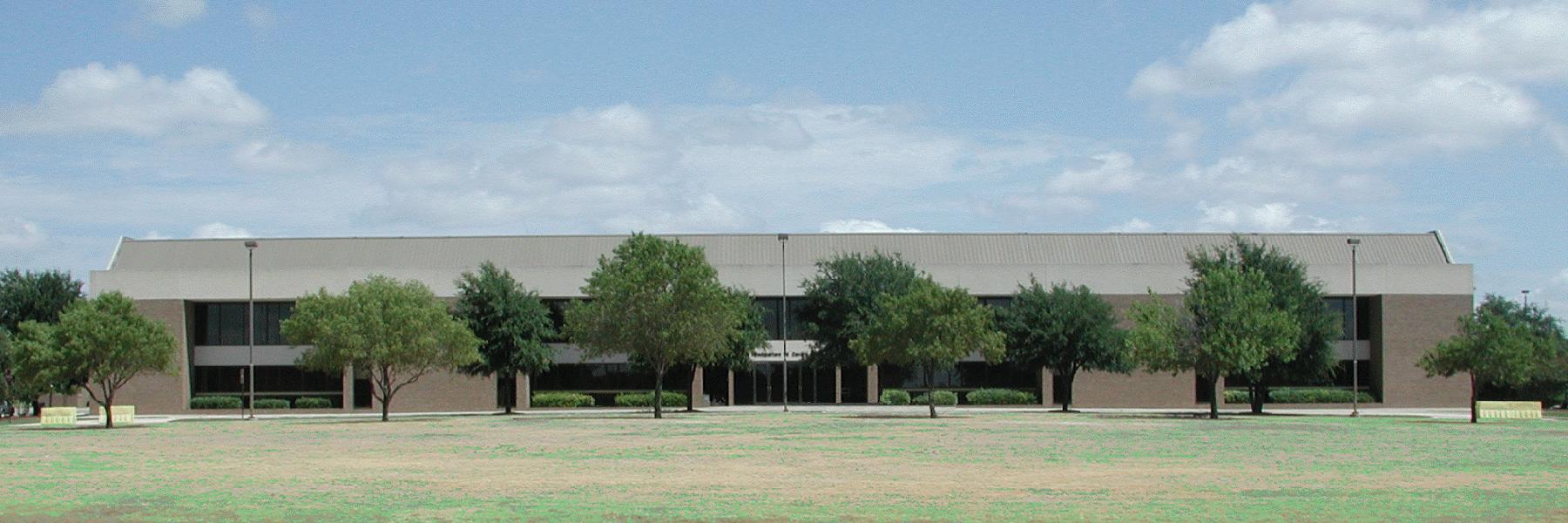 |
|---|
| 1st Cavalry Division Headquarters - 1980 |
|---|
 The opening ceremonies for the new 1st Cavalry Division Headquarters Building
were held in July. A modern brick, 124,000 square-foot facility replaced the
original World War II structures, enabling the housing of the Division Staff
under one roof. Major General William C. Chase (Retired), who commanded the
Division in the final days of World War II through the occupation of Japan,
participated in the ribbon cutting which was held during the 36th reunion of
the Association.
The opening ceremonies for the new 1st Cavalry Division Headquarters Building
were held in July. A modern brick, 124,000 square-foot facility replaced the
original World War II structures, enabling the housing of the Division Staff
under one roof. Major General William C. Chase (Retired), who commanded the
Division in the final days of World War II through the occupation of Japan,
participated in the ribbon cutting which was held during the 36th reunion of
the Association.
 Operational testing of the new M-1 Abrams tank continued through the spring
and summer of '81. Once the M-1 tests were completed, the 2nd Battalion, 12th
Cavalry, a mechanized/infantry battalion, was reorganized as an armor
battalion and on 15 December 1981, was relieved from assignment to the 1st
Cavalry Division. Equipment and personnel were redesignated as the 3rd
Battalion, 10th Cavalry and remained assigned to the 1st Cavalry
Division.
Operational testing of the new M-1 Abrams tank continued through the spring
and summer of '81. Once the M-1 tests were completed, the 2nd Battalion, 12th
Cavalry, a mechanized/infantry battalion, was reorganized as an armor
battalion and on 15 December 1981, was relieved from assignment to the 1st
Cavalry Division. Equipment and personnel were redesignated as the 3rd
Battalion, 10th Cavalry and remained assigned to the 1st Cavalry
Division.
 In September 1982, the division's first National Training Center (NTC)
rotation at Fort Irwin, located in the High Mojave Desert of California,
kicked off a long on-going series of tough, realistic desert battles which
enables the division to stay on the leading edge of warfare technology of
today. The first units to attend were the 2nd Battalion, 7th Cavalry and 3rd
Battalion, 10th Cavalry of the 2nd Brigade. The Division now conducts three
NTC rotations per year.
In September 1982, the division's first National Training Center (NTC)
rotation at Fort Irwin, located in the High Mojave Desert of California,
kicked off a long on-going series of tough, realistic desert battles which
enables the division to stay on the leading edge of warfare technology of
today. The first units to attend were the 2nd Battalion, 7th Cavalry and 3rd
Battalion, 10th Cavalry of the 2nd Brigade. The Division now conducts three
NTC rotations per year.
 On 15 June 1983, the 1st Battalion, 12th Cavalry Regiment was relieved from
assignment to the 1st Cavalry Division at Fort Hood, Texas. In the fall of
1983, the division deployed to Europe for the annual REturn of FORces to
GERmany (REFORGER) exercises. This deployment was consistent with the
contingency plans for its NATO reinforcement role. REFORGER '83 was the
largest deployment of the division since Vietnam. A real test of war equipment
repositioned stocks, REFORGER also marked the first time the exercise was lead
by the Dutch.
On 15 June 1983, the 1st Battalion, 12th Cavalry Regiment was relieved from
assignment to the 1st Cavalry Division at Fort Hood, Texas. In the fall of
1983, the division deployed to Europe for the annual REturn of FORces to
GERmany (REFORGER) exercises. This deployment was consistent with the
contingency plans for its NATO reinforcement role. REFORGER '83 was the
largest deployment of the division since Vietnam. A real test of war equipment
repositioned stocks, REFORGER also marked the first time the exercise was lead
by the Dutch.
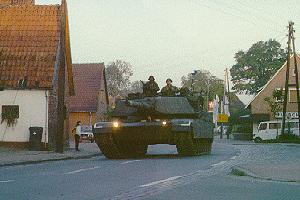 |
|---|
| Return of Forces to Germany |
|---|
| |
|---|
 In the summer of 1987, the 1st Cavalry Division deployed on REFORGER '87 with the
2nd Armored Division. With the decline of the role of the Warsaw Pact, the
sizes of subsequent REFORGER deployments were reduced, but command and control
elements continued to evaluate the need for equipment types and repositioning
of "war stocks" along with development of contingency plans to ensure the
reliability and effectiveness of combat readiness, should deployment become
necessary.
In the summer of 1987, the 1st Cavalry Division deployed on REFORGER '87 with the
2nd Armored Division. With the decline of the role of the Warsaw Pact, the
sizes of subsequent REFORGER deployments were reduced, but command and control
elements continued to evaluate the need for equipment types and repositioning
of "war stocks" along with development of contingency plans to ensure the
reliability and effectiveness of combat readiness, should deployment become
necessary.
 At Fort Hood, the division, through deliberate planning, evolved into the
combat unit which would be eventually assigned a major role in the Gulf War.
Along with the constant training of personnel, equipment was updated. The
XM-1 tank, renamed the M1 Abrams, was accepted and issued, along with
the BFV (Bradley M2 Infantry) and CFV (M3 Cavalry) fighting vehicles. New
technology was fielded in the MLRS (Multiple Launched Rocket Systems) and the
AH-64 Apache helicopter with its "Hellfire" guided missile. The old reliable
Jeep bowed to the HEMTT (Heavy Expanded Multi-purpose Tactical Truck), capable
of hauling fuel, ammunition and various cargos, and the HMMWV (High Mobility
Multi-purpose Wheeled Vehicle, configured as troop/cargo carrier, light
armored personnel carrier, communications equipment carrier and ambulance, -
both of which proved to be invaluable in the Gulf War.
At Fort Hood, the division, through deliberate planning, evolved into the
combat unit which would be eventually assigned a major role in the Gulf War.
Along with the constant training of personnel, equipment was updated. The
XM-1 tank, renamed the M1 Abrams, was accepted and issued, along with
the BFV (Bradley M2 Infantry) and CFV (M3 Cavalry) fighting vehicles. New
technology was fielded in the MLRS (Multiple Launched Rocket Systems) and the
AH-64 Apache helicopter with its "Hellfire" guided missile. The old reliable
Jeep bowed to the HEMTT (Heavy Expanded Multi-purpose Tactical Truck), capable
of hauling fuel, ammunition and various cargos, and the HMMWV (High Mobility
Multi-purpose Wheeled Vehicle, configured as troop/cargo carrier, light
armored personnel carrier, communications equipment carrier and ambulance, -
both of which proved to be invaluable in the Gulf War.
 It would not be until the end of the Gulf War and subsequent reorganization of
16 December 1992, when the 1st Battalion, 32nd Armor was redesignated as the
2nd Battalion, 12th Cavalry Regiment and the 3rd Battalion, 32nd Armor was
redesignated as the 1st Battalion, 12th Cavalry Regiment and assigned to the
1st Cavalry Division at Fort Hood, Texas filling out the present organization
structure of today.
It would not be until the end of the Gulf War and subsequent reorganization of
16 December 1992, when the 1st Battalion, 32nd Armor was redesignated as the
2nd Battalion, 12th Cavalry Regiment and the 3rd Battalion, 32nd Armor was
redesignated as the 1st Battalion, 12th Cavalry Regiment and assigned to the
1st Cavalry Division at Fort Hood, Texas filling out the present organization
structure of today.


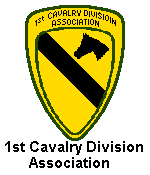














 eMail Your WebSite Comments.
eMail Your WebSite Comments.


 Return to "MyOwnPages"©.
Return to "MyOwnPages"©.

Copyright © 1996, Cavalry Outpost Publications ® and
Trooper Wm. H. Boudreau, "F" Troop, 8th Cavalry Regiment (1946 - 1947). All
rights to this body of work are reserved and are not in the public domain, or
as noted in the bibliography. Reproduction, or transfer by electronic means,
of the History of the 1st Cavalry Division, the subordinate units or any
internal element, is not permitted without prior authorization. Readers are
encouraged to link to any of the pages of this Web site, provided that proper
acknowledgment attributing to the source of the data is made. The information
or content of the material contained herein is subject to change without
notice.
Revised 08 Nov '09 SpellChecked